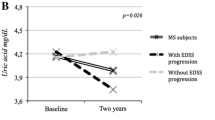Abstract
It has been reported that patients with multiple sclerosis (MS) exhibit lower serum uric acid levels; however, the association between uric acid concentrations and benign MS (BMS) has not been assessed. Hence, the objective of the present study was to determine whether the serum concentrations of uric acid are associated with the presence of BMS. Men and non-pregnant women over 16 years of age with diagnosis of MS were enrolled in a cross-sectional study. Expanded Disability Status Scale score < 3, progression of disease ≤10 years, diabetes, renal or hepatic diseases, gout, malignancy, alcohol intake, and treatment with thiazide diuretics and/or acetylsalicylic acid were exclusion criteria. According to subtype of disease, the eligible patients were allocated into groups with BMS and other varieties of MS. A logistic regression analysis was conducted in order to evaluate the association between serum concentrations of uric acid and BMS. A total of 106 patients were included, 39 in the group with BMS and 67 in the group with other varieties of MS. The logistic regression analysis adjusted by age, sex, and disease duration showed that increased concentrations of uric acid, indeed within the physiological levels, are significantly associated with the presence of BMS (OR = 2.60; 95% CI: 1.55–4.38, p < 0.001). The results of the present study suggest that elevated concentrations of uric acid, indeed within the physiological range, are likely linked to the presence of BMS.
Similar content being viewed by others
References
Ebers GC (2008) Environmental factors and multiple sclerosis. Lancet Neurol 7(3):268–277
Zostawa J, Adamczyk J, Sowa P, Adamczyk-Sowa M (2017) The influence of sodium on pathophysiology of multiple sclerosis. Neurol Sci 38(3):389–398
Traugott U, Reinherz EL, Raine CS (1983) Multiple sclerosis. Distribution of T cells, T cell subsets and Ia-positive macrophages in lesions of different ages. J Neuroimmunol 4(3):201–221
Raine CS (1994) The Dale E. McFarlin memorial lecture: the immunology of the multiple sclerosis lesion. Ann Neurol 36(Suppl):S61–S72
Noseworthy JH, Lucchinetti C, Rodriguez M, Weinshenker BG (2000) Multiple sclerosis. N Engl J Med 343(13):938–952
Liu B, Shen Y, Xiao K, Tang Y, Cen L, Wei J (2012) Serum uric acid levels in patients with multiple sclerosis: a meta-analysis. Neurol Res 34(2):163–171
Wang L, Hu W, Wang J, Qian W, Xiao H (2016) Low serum uric acid levels in patients with multiple sclerosis and neuromyelitis optica: an updated meta-analysis. Mult Scler Relat Disord 9:17–22
Guerrero AL, Gutiérrez F, Iglesias F, Martín-Polo J, Merino S, Martín-Serradilla JI, Laherrán E, Tejero MA (2011) Serum uric acid levels in multiple sclerosis patients inversely correlate with disability. Neurol Sci 32(2):347–350
Maesaka JK, Wolf-Klein G, Piccione JM, Ma CM (1993) Hypouricemia, abnormal renal tubular urate transport, and plasma natriuretic factor(s) in patients with Alzheimer’s disease. J Am Geriatr Soc 41(5):501–506
Toncev G, Milicic B, Toncev S, Samardzic G (2002) Serum uric acid levels in multiple sclerosis patients correlate with activity of disease and blood-brain barrier dysfunction. Eur J Neurol 9(3):221–226
Kalnovičová T, Turčáni P (2009) Plasma uric acid levels in multiple sclerosis patients as a marker of disease activity and blood–brain barrier dysfunction. Psychiatrie 13:80–81
Polman CH, Reingold SC, Banwell B, Clanet M, Cohen JA, Filippi M, Fujihara K, Havrdova E, Hutchinson M, Kappos L, Lublin FD, Montalban X, O'Connor P, Sandberg-Wollheim M, Thompson AJ, Waubant E, Weinshenker B, Wolinsky JS (2011) Diagnostic criteria for multiple sclerosis: 2010 revisions to the McDonald criteria. Ann Neurol 69(2):292–302
Sayao AL, Devonshire V, Tremlett H (2007) Longitudinal follow-up of “benign” multiple sclerosis at 20 years. Neurology 68(7):496–500
Katz Sand I (2015) Classification, diagnosis, and differential diagnosis of multiple sclerosis. Curr Opin Neurol 28(3):193–205
Sotgiu S, Pugliatti M, Sanna A, Sotgiu A, Fois ML, Arru G, Rosati G (2002) Serum uric acid and multiple sclerosis. Neurol Sci 23(4):183–188
Fang P, Li X, Luo JJ, Wang H, Yang XF (2013) A double-edged sword: uric acid and neurological disorders. Brain Disord Ther 2(2):109
Drulović J, Dujmović I, Stojsavljević N, Mesaros S, Andjelković S, Miljković D, Perić V, Dragutinović G, Marinković J, Lević Z, Mostarica Stojković M (2001) Uric acid levels in sera from patients with multiple sclerosis. J Neurol 248(2):121–126
van der Veen RC, Hinton DR, Incardonna F, Hofman FM (1997) Extensive peroxynitrite activity during progressive stages of central nervous system inflammation. J Neuroimmunol 77(1):1–7
Ramsaransing GS, Heersema DJ, De Keyser J (2005) Serum uric acid, dehydroepiandrosterone sulphate, and apolipoprotein E genotype in benign vs. progressive multiple sclerosis. Eur J Neurol 12(7):514–518
Hooper DC, Bagasra O, Marini JC, Zborek A, Ohnishi ST, Kean R, Champion JM, Sarker AB, Bobroski L, Farber JL, Akaike T, Maeda H, Koprowski H (1997) Prevention of experimental allergic encephalomyelitis by targeting nitric oxide and peroxynitrite: implications for the treatment of multiple sclerosis. Proc Natl Acad Sci U S A 94(6):2528–2533
Hooper DC, Spitsin S, Kean RB, Champion JM, Dickson GM, Chaudhry I, Koprowski H (1998) Uric acid, a natural scavenger of peroxynitrite, in experimental allergic encephalomyelitis and multiple sclerosis. Proc Natl Acad Sci U S A 95(2):675–680
Spitsin S, Hooper DC, Leist T, Streletz LJ, Mikheeva T, Koprowskil H (2001) Inactivation of peroxynitrite in multiple sclerosis patients after oral administration of inosine may suggest possible approaches to therapy of the disease. Mult Scler 7(5):313–319
Constantinescu CS, Freitag P, Kappos L (2000) Increase in serum levels of uric acid, an endogenous antioxidant, under treatment with glatiramer acetate for multiple sclerosis. Mult Scler 6(6):378–381
Rivera VM, Medina MT, Duron RM, Macias MA (2014) Multiple sclerosis care in Latin America. Neurology 82(18):1660–1661
Acknowledgments
We would like to thank the Department of Neurology from the Hospital de Especialidades del Centro Médico Nacional “La Raza”, México City.
Author information
Authors and Affiliations
Corresponding author
Ethics declarations
Conflicts of interest
The authors declare that they have no conflict of interest.
Rights and permissions
About this article
Cite this article
Simental-Mendía, E., Simental-Mendía, L.E. & Guerrero-Romero, F. Serum uric acid concentrations are directly associated with the presence of benign multiple sclerosis. Neurol Sci 38, 1665–1669 (2017). https://doi.org/10.1007/s10072-017-3043-1
Received:
Accepted:
Published:
Issue Date:
DOI: https://doi.org/10.1007/s10072-017-3043-1




